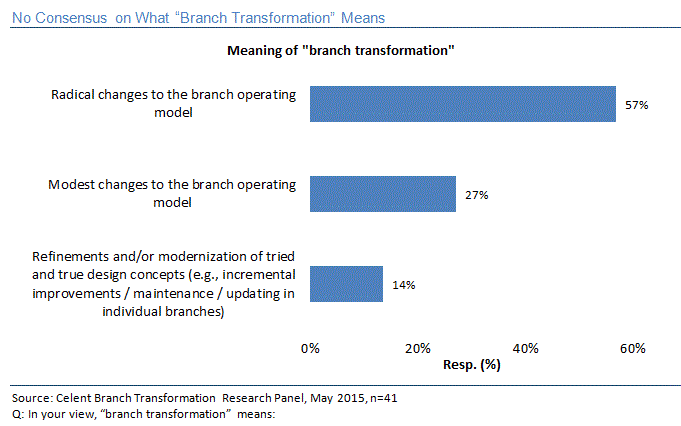These Early Days of Branch Channel Transformation
Celent Branch Transformation Panel Series Part 1
Abstract
The face of branch banking won’t be changing quickly. Most surveyed institutions agree that branch channel transformation is “imperative,” but there is broad disagreement on what that looks like.

In the report These Early Days of Branch Channel Transformation, Celent offers an analysis of its inaugural Branch Transformation Research Panel survey, which confirms that US financial institutions have a long road ahead of them as they seek to migrate branch networks from transaction centers to a sales and service delivery channel.
In the survey conducted online in May and June 2015, 81% of responding institutions agreed that branch channel transformation was “imperative,” but there was no consensus on what branch transformation implies.

Several additional insights from the research include:
- Panelists give their current branch infrastructures a grade of C+ and, for the most part, consider themselves average (39%) or above average (47%) compared to peers. No one gave their institution an A.
- Panelists think organizational aspects of the current network (roles, staffing levels, expertise, etc.) are comparatively better off, whereas hardware/software environments and multichannel coordination need considerable work.
- Just 1 in 10 said that they have a clear vision toward the future branch. About half of the institutions surveyed are actively developing a vision, while the rest are wholly lacking.
- These are early days. A substantial industry transformation will likely take five or more years. While 70% of panelists are actively pursuing initiatives, only 35% are refining designs or deploying new branch designs. The significant majority of institutions are fielding more fledgling efforts.
- There will likely be a rich diversity in new branch technology, yet a number of elements will be relatively commonplace; tablets, digital signage, cash recycling, and assisted self-service. Video tellers and interactive walls, not so much.
- A similar diversity will avail itself in physical designs, with concierges, meeting rooms, drive-thru ATMs, and lounge areas looking to become common elements. A surprising number of banks see longevity in drive-thru tellers, cash vaults, and traditional teller stations.
“Motivated to grow top line revenue and improve efficiency ratios, financial institutions across the asset tiers are motivated to improve branch channel efficiency and effectiveness,” says Bob Meara, a senior analyst with Celent’s Banking practice and coauthor of the report. “But, these are still early days, with just 1 in 10 surveyed institutions having a clear vision for the future branch.”
This is the first of a series of reports based on Celent’s newly created Branch Transformation Research Panel. The purpose of the effort is to look deeply into the objectives, priorities, risks, barriers, and likely outcomes of the growing trend that is branch channel transformation in North America. Panelists were recruited among Celent clients and nonclients alike. Celent is accepting additional requests for membership in the panel and expects to field ongoing research through 2016 at semi-monthly intervals. To request to be on the Branch Transformation Research Panel, contact info@celent.com.
This report contains 16 figures.

